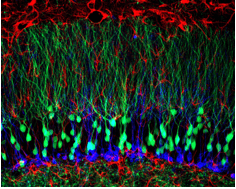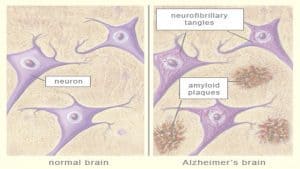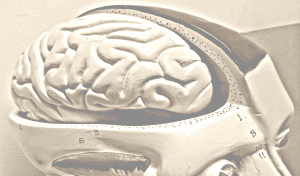Since childhood, we have heard about the five senses in many scenarios: at school, on the TV, at home, etc. Such senses have been considered our sensory organs par excellence; however, which sense is actually acting when we feel heat? What about when we perceive pain?
According to the traditional classification, the organs of these five senses are considered the main sensory organs. Nevertheless, there are many more, such asnociception -sense of pain-, thermoception -sense of temperature-, or chemical communication -transmission of chemical substances such as neurotransmitters, hormones or pheromones, which allow individuals to communicate with each other or with the environment that surrounds them.
Although there are thousands of chemical compounds involved in the interaction among living beings, if we type in Google “chemical communication” or “semiochemistry”, the first compounds that appear to be responsible for the chemical interaction among individuals are pheromones. These substances allow to transmit information from one organism to another causing some kind of physiological or behavioural change in the organism that receives the information. It should be highlighted that pheromonal information is always transmitted between animals within the same species and through an innate and unconscious behaviour. It seems to be a bit complex to understand, but let’s explain it with an example: in rabbits, there is a well-known pheromone, 2-methylbut-2enal (2MB2), which lactating mothers release from their mammary glands towards the environment. As soon as rabbits are born, they take this substance from their mothers, which will rapidly stimulate the nipple sucking reflex and in turn guarantee their nourishment during their first hours of life. Young rabbits come to their mother’s nipple before opening their eyes and without anyone “teaching” them that this is the right place to ask for food.
This is an example of innate communication – not learned – as well as unconscious, in this case mediated by the pheromone 2MB2. Only after several times of nursing, pups will acquire the knowledge that allows them to associate the nipple with food, and only from that moment on the pheromonal effect of the 2MB2 does not seem to be essential. There are some studies which show that pups born by caesarean section prematurely already have a suction reflex, and this suggests the maturity of the vomeronasal system (Figure 1), the system in charge of picking up pheromones, already in prenatal stages.
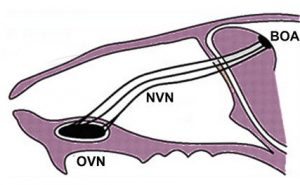
Figure 1. Vomeronasal system scheme. There is a direct connection between the vomeronasal organ (OVN) and one specific region of the brain, the accesory olfactory bulb (BOA), through the vomeronasal nerves (NVN).
Within the vomeronasal system, also known as the accessory olfactory system, we find the vomeronasal organ (Figure 2), responsible for receiving pheromones from the outside.
To explain how it works, we can imagine that we want to plant a kitchen-garden and we need a water system to water the vegetables. This system is made up of a tube to which a pump is connected in order to promote the passage of water to the entire harvest. This tube would correspond to the vomeronasal organ, a paired structure located in the lower part of the nose. It has a pumping system called vomeronasal pump –blood vessels that are under continuous dilation and contraction– which facilitates the passage of pheromones through it. Now, we have to imagine that this tube has an outlet for each lettuce, cauliflower, leek or carrot; ensuring therefore a correct watering of every vegetable and, consequently, an adequate growth of the whole harvest. If we compare it with our system, we have to imagine that “water” is the pheromones and each water molecule is responsible to “make a specific vegetable grow” or, in other words, each pheromone is responsible for “triggering a specific behavior”. Each output of the tube corresponds to a vomeronasal receptor, all of them located in neurons within the vomeronasal organ.
If this system works correctly, the plants will receive their nutrients and grow adequately. It happens the same way in our case: if the pheromone-receptor binding is correct, the information will be sent directly to the central nervous system where complex circuits will be responsible for producing the desired effect – a change of behavior, for example.
There are numerous examples of behavioural changes in animals associated with pheromone effects. One striking instance is the Bruce Effect, widely studied in mice, which consists of the female exposure to the urine of a male different from the parent of the litter, during the first stages of pregnancy. Surprisingly, there are many cases where the female aborts under these conditions. But why does it happen? Well, the most widespread reason is that the mother tries to protect their offspring from strangers. Under a threatening situation in which a male that is not the father of the offspring could kill the pups once they are born, mothers reduce her prolactin levels (a pregnancy hormone), causing a miscarriage. However, it has not yet been discovered which urine compounds are responsible for producing this effect and to which vomeronasal receptors they are bound to.
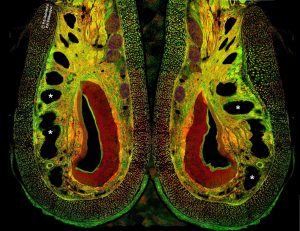
Figure 2. Vomeronasal organ in rabbits, structure presented bilaterally and encapsulated by cartilage. It is highlighted the considerable size of blood vessels (*) in its lateral part as well as their epithelium thickness (maroon), medially located.
Although there has been a wide range of studies on the behavioural effects associated with pheromones, little is known about which compounds are responsible for these effects and how the pheromone-receptor binding takes place. In other words, we know what is happening but we do not know either how it is happening, or what molecules are the responsible. We also do not have information about which receptors are involved in the detection of each molecule, nor what is that union like. It is a challenge to tackle all these questions, but it would undoubtedly solve many current questions as well as open a wide field of study to work on animal behavior. Researchers within this field will potentially be able to assess and even control certain unwanted behaviors -dominance, aggression, stress, etc-.
These types of studies are an important scientific challenge, since they must be carried out in each species separately due to the species-specific nature of the pheromones and also because of the great morphological variability of the vomeronasal system among different species.
All in all, a multidisciplinary and collaborative approach is necessary, including areas such as neuroanatomy, biochemistry, molecular genetics and practical studies involving ethology (behavioural study) and reproduction, among others. We are definitely facing a promising field of research with a great translational character, but after this post we all know that there is still much work to be done.
Post by Paula Rodríguez Villamayor, PhD student Universidad de Santiago de Compostela.

